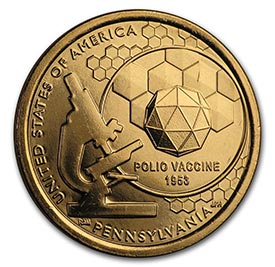
American Innovation Dollar (2018-)
Commemorative coins have a long and storied history with origins dating all the way back to Classical Greece. From the Mughals to the West Germans, governments have created special coins created to memorialize great people and events. Commemoratives are collectibles, and usually are not made for circulation (though they may be in some cases, such as the 50 State Quarters or Washington quarter).
These coins are almost always historically significant and are usually issued either for commemorations or to collect money for monuments or celebrations. Before 1982, U.S. commemorative coins were often created by a commission in charge of the event. The coins would be sold for a premium over the regular price of the coin to collect seigniorage. After 1982 commemoratives came through the U.S. Mint. Some of these still had the old Precious Metal content of previous years while others were only clad coins. The American Innovation dollar falls in the latter category.
American Innovation Dollar Design
The American Innovation dollar was signed into law on June 20, 2018. Like the other post-Sacajawea dollars, the American Innovation was never meant for circulation. It is struck in regular Brilliant Uncirculated condition as well as proof and reverse proof. Some of these were also sold in sets. The design rotates, with reverses designed to honor examples of innovation from all the states and territories as well as the District of Columbia. The obverse shows a picture of the Statue of Liberty.
The American Innovation dollar is composed of 77% Copper, 12% zinc, 7% manganese and 4% nickel around a core of pure Copper. Unlike many other collectible commemoratives, these are not available in Precious Metal versions. Uncirculated coins are minted in Philadelphia and Denver, while proof and reverse proof coins come exclusively from the San Francisco Mint.
Modern commemorative coin issues like the American Innovation series were sold after 1982 and did not have the same selling structure as previous commemoratives. These were unique, but they were not sold by a commission. Instead, they came directly from the U.S. Mint, but for the same purpose of collecting seignorage. There are exceptions (such as the Mount Rushmore Golden Anniversary, which was split between the Treasury and the Mount Rushmore National Memorial Society of Black Hills, South Dakota), but most fall under this pattern. These coins have smaller mintages than commemorative coins of the past and collectors are more willing to take them on.
The modern U.S. dollar honors notable figures and groups, and the American Innovation dollar celebrates many facets of the American spirit. From inventions to athletics and from valleys to canals, the American Innovation dollar pays homage to the people, places, and things that enrich the fabric of the nation.
Historical Significance
Most commemorative issues are tied to a specific event or historical anniversary, so they have some historical significance. Commemoratives may not have come out at the time of the event, but they are reminders of it and some of the designs were done by very famous coin designers and sculptors of the day.
Modern commemoratives are cheaper to buy than older commemoratives, despite low mintages. That may change as time goes on and they get rarer.
Numismatic Value
Commemorative value can be volatile. Many of them had low mintages and surviving populations, which can drive prices up dramatically. Some issues were firsts, including the first U.S. coin to have a U.S. president and the first U.S. coin to have a living president. Modern commemoratives have low mintages but are less expensive to collect than older ones, and clad coins like the American Innovation dollar do not have the intrinsic value of the Precious Metal supporting their price. Commemorative value isn’t completely stable and is worth checking on a more regular basis than some other coins.
If you’re ready to shop for Innovation dollars or other commemoratives, shop our extensive selection of rare coins today.

PCGS Products
You need the most up-to-date pricing on your coin collection. That’s why APMEX has partnered with PCGS, the premier grading authority in the world of rare coins, to bring you constantly updated pricing on collectibles and rarities. PCGS has been grading coins since 1986, bringing consistent standards of quality to a fractured industry. In the years since they have remained a source of reliable information on the current collectible and rare coin market.




